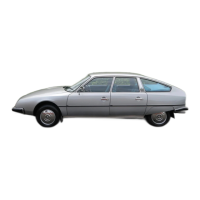..i
7_r
:II
`J'
`4, 'L5
F,_,
0.,
O..
ASS
't3
t.4
'47
...
,n.
R..
r-.
Cl.
ute,
uti
Uti
,J3
.".
Cl.
.-q
2
OPERATION
N° MA. 390-0
Chcking IIe hvdraulic
cornpone-nis on threhécl
(
Manual sttering vehic/es )
CHEOKS
4. Checking the
main
accumulator
1
1b4
.'
-z-J
'-&__&_
....
,'I.
1
a)
Disconnect HP
inlet
pipe
(1) from
sal
ety
valve.
b)
Plug
HP
inlet pipe
(iising /ugs
D and l
).
c)
Tighten
pressure regulator
bleed screw.
Disconnect contact
breaker
lead from coil.
Operate
starterwatching
the pressure
gauge
the pressure should
rise steadily and
then
appear
to stabilize.
Note
this reading,
which is the inflation
pressure of
accumulutor.
This
pressure
must equai 62
bars
(899
psi
)
Coimect leud
of contact breoker
5.
Checking cut-out
o
)
(hcing cut-out ressnre
Start engine.
With pressure
regulator bleed screw tightened,
examine the
pressure gauge.
When pressure stops rising,
reading
indicates
maximum cut-out pressure.
This pressure
must be egual
to 170±5 bars
(2466±73psi
).
When the cut-out
pressure is
obtained
allow
the
engine to run for a few
rninutes in order
to stabilize pressure.
Stop engine.
Examine
the pressure
gauge and
note the fall
in
pressure
for the next 3 minutes.
If
the
fall inpressure exceeds
10
bars
(l45psi)
check seal
of plug
D and
repeat
the test
suence.
If
the result
of
test
is
the
same,
the pressure
regulator is defective.
Replace
it or
repair
it.
b
)
(h ck/n
g
the cut.in pr.ssurc
Start engine.
When
cut-out takes
place, slightly slacken
pressure
regulator
bleed screw.
The pressure
should fall gently then
rise as..
soon as the
HP
purnp begins
to
opernte.
The minimum
reading indicated
on the
prssure
gauge
corresponds
to
the cut-in
pressure.
This press ure
must be
145 ±5 bars
(2103 ±73
psi
).
If these cut-tin and cut-out
pressures
do
not lie within the
given tolerances, check the
pressure regulator.
c)
Slacken the pressure
regulator bleed
screw.
d)
Remove plug D and
connect HP inlet
pipe
(1)
to safety valve.
PDF compression, OCR, web-optimization with CVISION's PdfCompressor

